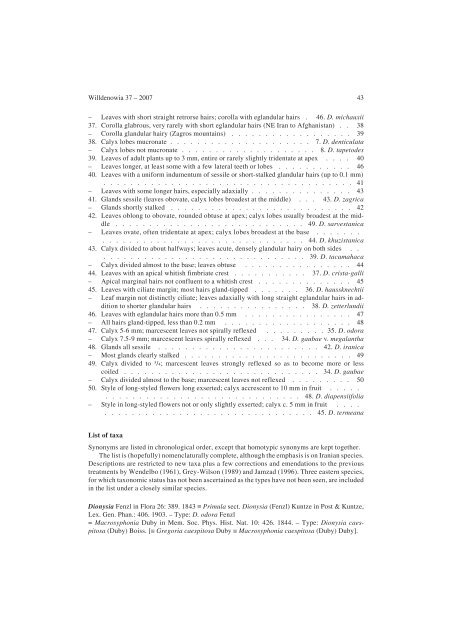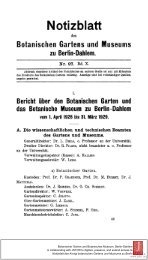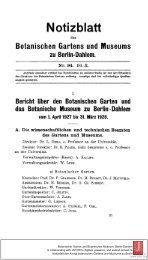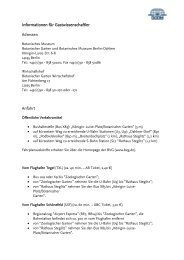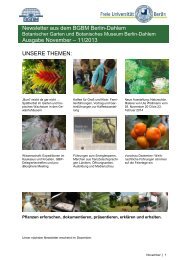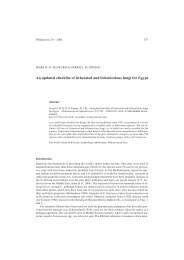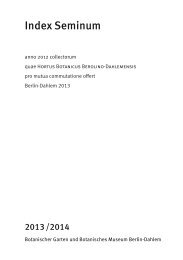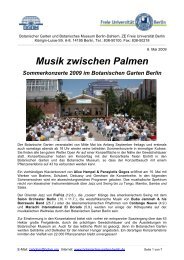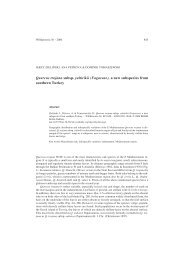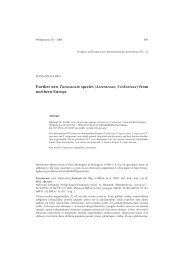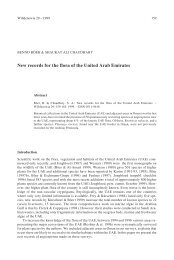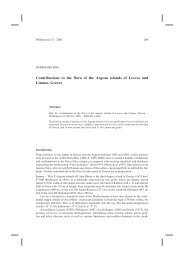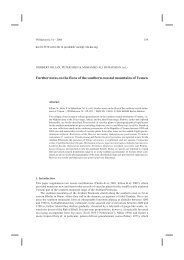The genus Dionysia (Primulaceae), a synopsis and five new species
The genus Dionysia (Primulaceae), a synopsis and five new species
The genus Dionysia (Primulaceae), a synopsis and five new species
You also want an ePaper? Increase the reach of your titles
YUMPU automatically turns print PDFs into web optimized ePapers that Google loves.
Willdenowia 37 – 2007 43<br />
– Leaves with short straight retrorse hairs; corolla with egl<strong>and</strong>ular hairs . 46. D. michauxii<br />
37. Corolla glabrous, very rarely with short egl<strong>and</strong>ular hairs (NE Iran to Afghanistan) . . 38<br />
– Corolla gl<strong>and</strong>ular hairy (Zagros mountains) . . . . . . . . . . . . . . . . . . 39<br />
38. Calyx lobes mucronate . . . . . . . . . . . . . . . . . . . . . 7. D. denticulata<br />
– Calyx lobes not mucronate . . . . . . . . . . . . . . . . . . . . 8. D. tapetodes<br />
39. Leaves of adult plants up to 3 mm, entire or rarely slightly tridentate at apex . . . . 40<br />
– Leaves longer, at least some with a few lateral teeth or lobes . . . . . . . . . . . 46<br />
40. Leaves with a uniform indumentum of sessile or short-stalked gl<strong>and</strong>ular hairs (up to 0.1 mm)<br />
. . . . . . . . . . . . . . . . . . . . . . . . . . . . . . . . . . . . . 41<br />
– Leaves with some longer hairs, especially adaxially . . . . . . . . . . . . . . . 43<br />
41. Gl<strong>and</strong>s sessile (leaves obovate, calyx lobes broadest at the middle) . . . 43. D. zagrica<br />
– Gl<strong>and</strong>s shortly stalked . . . . . . . . . . . . . . . . . . . . . . . . . . . 42<br />
42. Leaves oblong to obovate, rounded obtuse at apex; calyx lobes usually broadest at the middle<br />
. . . . . . . . . . . . . . . . . . . . . . . . . . . . 49. D. sarvestanica<br />
– Leaves ovate, often tridentate at apex; calyx lobes broadest at the base . . . . . . .<br />
. . . . . . . . . . . . . . . . . . . . . . . . . . . . . . 44. D. khuzistanica<br />
43. Calyx divided to about halfways; leaves acute, densely gl<strong>and</strong>ular hairy on both sides . .<br />
. . . . . . . . . . . . . . . . . . . . . . . . . . . . . . 39. D. tacamahaca<br />
– Calyx divided almost to the base; leaves obtuse . . . . . . . . . . . . . . . . 44<br />
44. Leaves with an apical whitish fimbriate crest . . . . . . . . . . . 37. D. crista-galli<br />
– Apical marginal hairs not confluent to a whitish crest . . . . . . . . . . . . . . 45<br />
45. Leaves with ciliate margin; most hairs gl<strong>and</strong>-tipped . . . . . . . 36. D. haussknechtii<br />
– Leaf margin not distinctly ciliate; leaves adaxially with long straight egl<strong>and</strong>ular hairs in addition<br />
to shorter gl<strong>and</strong>ular hairs . . . . . . . . . . . . . . . . 38. D. zetterlundii<br />
46. Leaves with egl<strong>and</strong>ular hairs more than 0.5 mm . . . . . . . . . . . . . . . . 47<br />
– All hairs gl<strong>and</strong>-tipped, less than 0.2 mm . . . . . . . . . . . . . . . . . . . 48<br />
47. Calyx 5-6 mm; marcescent leaves not spirally reflexed . . . . . . . . . 35. D. odora<br />
– Calyx 7.5-9 mm; marcescent leaves spirally reflexed . . . 34. D. gaubae v. megalantha<br />
48. Gl<strong>and</strong>s all sessile . . . . . . . . . . . . . . . . . . . . . . . . 42. D. iranica<br />
– Most gl<strong>and</strong>s clearly stalked . . . . . . . . . . . . . . . . . . . . . . . . . 49<br />
49. Calyx divided to 3 /4; marcescent leaves strongly reflexed so as to become more or less<br />
coiled . . . . . . . . . . . . . . . . . . . . . . . . . . . . . 34. D. gaubae<br />
– Calyx divided almost to the base; marcescent leaves not reflexed . . . . . . . . . 50<br />
50. Style of long-styled flowers long exserted; calyx accrescent to 10 mm in fruit . . . . .<br />
. . . . . . . . . . . . . . . . . . . . . . . . . . . . . 48. D. diapensiifolia<br />
– Style in long-styled flowers not or only slightly exserted; calyx c. 5 mm in fruit . . . .<br />
. . . . . . . . . . . . . . . . . . . . . . . . . . . . . . . 45. D. termeana<br />
List of taxa<br />
Synonyms are listed in chronological order, except that homotypic synonyms are kept together.<br />
<strong>The</strong> list is (hopefully) nomenclaturally complete, although the emphasis is on Iranian <strong>species</strong>.<br />
Descriptions are restricted to <strong>new</strong> taxa plus a few corrections <strong>and</strong> emendations to the previous<br />
treatments by Wendelbo (1961), Grey-Wilson (1989) <strong>and</strong> Jamzad (1996). Three eastern <strong>species</strong>,<br />
for which taxonomic status has not been ascertained as the types have not been seen, are included<br />
in the list under a closely similar <strong>species</strong>.<br />
<strong>Dionysia</strong> Fenzl in Flora 26: 389. 1843 ≡ Primula sect. <strong>Dionysia</strong> (Fenzl) Kuntze in Post & Kuntze,<br />
Lex. Gen. Phan.: 406. 1903. – Type: D. odora Fenzl<br />
= Macrosyphonia Duby in Mem. Soc. Phys. Hist. Nat. 10: 426. 1844. – Type: <strong>Dionysia</strong> caespitosa<br />
(Duby) Boiss. [≡ Gregoria caespitosa Duby ≡ Macrosyphonia caespitosa (Duby) Duby].


